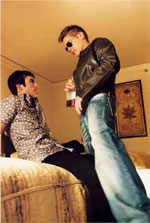Whatever Happened To Judd Nelson?
| |

|
OK, confession time. It's not big, it's not clever, and it's not even entirely ironic, but I still kinda like those John Hughes teen movies from the mid-80s. It's partly autobiographical. I was at high school in Canada around the time they came out, and the world of keg parties, jock vs. freak rivalries, rolled-up sleeves on linen jackets and who-to-take-to-the-prom trauma was pretty real. OK, all the films seemed to incorporate a visit to an 'alternative' nightspot that was about as authentic as the comedy punks who pose for tourists at London landmarks, but, hey, wraparound shades and tartan DMs aren't exactly weapons of mass destruction. And each movie did have room for a character with a genuine place in the indie-pop firmament. Anthony Michael Hall as the nerd in The
Breakfast Club clearly grew up to be Rivers Cuomo; Mary Stuart Masterson in Some
Kind Of Wonderful has the pouting, lovesick angst of Juliana Hatfield; and in Pretty
In Pink we have Jon Cryer's
Ducky, the blueprint for mouthy weirdos from Ian McCulloch to Bobby Conn and
Har Mar Superstar. The other artefacts that bring all the funny ghastliness of the decade rushing back are the early novels of Bret Easton Ellis. I first read Less Than Zero on an overnight train from Montreal to New York, and nearly hopped on a plane to LA as soon as I'd finished it, so attractive to a sallow, callow 18-year-old was the scent of horror and glamour and coke and nasty sex. Thus it was a tad disappointing to find that Roger Avary's adaptation of The Rules Of Attraction has shifted the action onwards a few years. Some of the signifiers are superficial and obvious; the girls' hair is mostly flat, not big; the boys wear Calvin trunks, not Kamen-style boxers; Lauren's fuck with a puking fratboy is caught on a digital camcorder; Victor's tour diary of Europe namechecks Tate Modern and a girl who looks like Rachael Leigh Cook. But the key change is not of content - it's a change of attitude, in that postmodernism has come to the masses. Although the film is clearly set in the 00s, the soundtrack could have come from a Hughes original, with Yazoo, The Cure and PIL creating the fanfares that ought to herald the nervous entrance of Molly Ringwald. Idiot bisexual boys pillowfight in their underwear to the sound of George Michael's 'Faith', an image that has far more resonance now than it would have had 15 years ago. (One could argue that the not-very-good-actually version of Less Than Zero played similar games with music, but The Bangles covering Simon & Garfunkel isn't postmodern - it's just unpleasant. Hey, Andrew McCarthy was in that...) Dialogue runs backwards (one for the Twin Peaks fans) and we even get a clunking dose of split-screen action (Abel Gance's Napoleon, anyone?). Avary refers back to himself, of course, a silent Expressionist movie spooling in the background just as Nosferatu did in his Killing Zo'. Above all, the cineaste/voyeur (an NYU film student of course!) films Lauren's humiliation while talking about Avary's sometime collaborator Tarantino. The virulent gangsta spiel of the drug-dealer Rupert is pure QT, which rather resurrects that thorny question of who exactly did write Pulp Fiction (although, of course, if we're being strictly postmodernist, nobody wrote it). And the casting of Eric Stoltz (who was also in Killing Zo' AND Pulp Fiction AND Some Kind Of Wonderful) as the lecherous lecturer ties everything together with a big shiny ribbon. Crucially, what Tarantino (or Avary, or Tarantino-and-Avary) has done for cinema, and wider pop culture, is to construct an artistic agenda where it's OK to namecheck the specific. The only hard-and-fast cultural references that the philosophising detainees of The Breakfast Club made were to Moliere and Barry Manilow. Maybe Hughes was trying to make the movie timeless, although the dancing of Emilio Estevez alone makes it as 80s as Live Aid. In The Rules Of Attraction, Victor not only mentions Paul Oakenfold, we actually see the man himself. In 15 or 20 years time, Oakenfold might be as much of an archaeological curio as Hughes's beloved Simple Minds are today. But because he translates Ellis's vile atmospheres so accurately to the screen, and because of the fractured, looping discourses that mainstream movie audiences can just about stomach these days, I suspect Avary's work (his adaptation of Glamorama, Ellis's sort-of-sequel, is in pre-production) might last a bit better. A friend of mine once said that Douglas Coupland was the Bret Easton Ellis who had a heart. Roger Avary might just be the Quentin Tarantino who occasionally read a book. © 2003 Tim Footman |